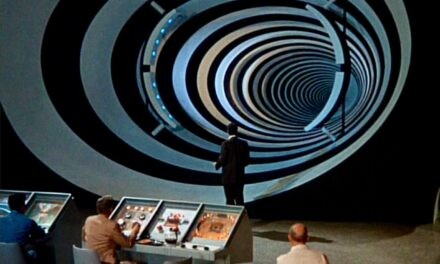Like many people, I binge-watch horror films or movie franchises in the run-up to Halloween. With the release of Saw X this October, I decided to revisit the series’ nine predecessors that belong to the wave of ‘torture porn’ films popularised in the 2000s. While many franchises employ serial storytelling, I was struck by how Saw felt more like ‘TV’ than other horror series I’ve watched over the years.
Before pondering why this is the case, I will briefly recap the film’s overarching plot (and then discuss the importance of recaps themselves). The central figure in the Saw franchise is John Kramer, also known as ‘Jigsaw.’ He is a successful civil engineer who, after having cancer and surviving an attempted suicide, chooses to spend the remaining time of his life testing other people’s will to live. Placing victims in elaborate and deadly traps, Jigsaw forces them to confront their own flaws as they make shocking and grisly choices to stay alive. Each film focuses on a different group of characters, brought together for a common reason, who find themselves in these deadly situations. Alongside this core narrative thread are two parallel storylines that create a rich, serialised tapestry: the first typically involves investigations into Jigsaw by law enforcement (both detectives and the police), and the second consists of backstories into Kramer, his victims, and accomplices.
Jordan Crucchiola, writing for Vulture, argues that ‘[d]espite how assaulting they are, Saw movies are actually best binged like a TV show — think of it as American Horror Black Mirror Story — because there are so many threads to hold on to, you need to watch as fast as possible to keep up’ (2023). In many ways, Saw effectively functions as ‘complex TV’ (Mittell, 2015), redefining episodic forms under the influence of serial narration. The first Saw aired shortly after the key prototypes for complex TV emerged in the 1990s, its sequels oscillating between standalone stories and ongoing narratives. What interests me, however, is how each film in the Saw franchise (bar the ninth – which is technically a spin-off) begins where the last ends. If you were to watch a Saw film at the cinema without recently seeing the previous film(s), you would have no idea what’s going on (unless you have a fantastic memory, unlike me). While audiences might only see these horror films to experience torture and gore, some understanding of the plot is necessary for an enjoyable viewing experience.
This is where memory-triggering strategies from television come into play. As Jason Mittell argues, ‘[c]omplex television requires viewers’ effort and attention for ongoing comprehension, strategically triggering, confounding, and playing with viewers’ memories via medium-specific poetic techniques’ (2015: 180). By comparison, he contends that cinematic narratives ‘typically engage a viewer’s short-term memory, cuing and obscuring moments from within the controlled unfolding of a two-hour feature film’ (ibid). Saw not only encourages us to remember what happens in the film’s confines, but its creative use of flashbacks urges the audience to recall how the story has progressed throughout the franchise. Flashbacks in Saw typically consist of critical scenes and dialogues from previous movies, reminding viewers of important plot points and the central themes of the series. It also typically links this narrative device with character subjectivity. For instance, most of John Kramer’s backstory is presented through flashbacks in Saw IV, and they provide new insights into the motivations and histories of other key characters, helping viewers understand their actions and decisions in the current film.
Simply put, ‘nonnaturalistic techniques [are used] to trigger recall’ (Mittell, 2015: 85), offering audiences new information (engaging their short-term memory) and old information (engaging their long-term memory). Sometimes, flashbacks can assault the viewer in their numerousness, and their non-linearity mimics the emotions of the characters trapped in Jigsaw’s games. Other times, they are used at the beginning of the film for memory-refreshing purposes, much like in television.
Additionally, generic expectations affected my perception of Saw as ‘TV.’ It combines elements of detective fiction (by focusing on detectives who work in semi-isolation), the police procedural (with realistic depictions of the force solving multiple murders), as well as horror, thriller, and mystery. Genre hybridity, in itself, is not televisual – but the ongoing nature of the crimes, the killer, and a (relatively) stable police force ensures that the franchise incorporates an extended process of detection. Each film is interconnected, building upon the events of the previous ones.
I’m merely being provocative in writing this piece, but it was refreshing to consider cinema as television rather than television as cinema for a change. And who knows, maybe Saw C will be made for TV.
Dr Laura Minor is a Lecturer in Television Studies at the University of Salford, UK. She is currently completing a book for Edinburgh University Press entitled Reclaiming Female Authorship in Contemporary UK Television Comedy. She is also writing a monograph with Dr Anthony Smith – Television Goes Back to the Future: Rethinking TV’s Streaming Revolution – for Palgrave Macmillan. Laura has previously been published in Feminist Media Studies, the Journal of British Cinema and Television, and the European Journal of Cultural Studies for her work on British screen cultures, women’s labour in the media industries, and representations of social class.
References
Crucchiola, J. (2023, 29 September). All 10 Saw Movies: Ranked. Vulture. https://vulture.com/article/every-saw-movie-ranked.html
Mittell, J. (2015). Complex TV: The Poetics of Contemporary Television Storytelling. New York University Press.







This is one of those posts/mini essays that needed to support the argument with detailed accounts of the way in which new instalments tie back in to previous ones, as to result into complex television. Otherwise it stays as a winking exercise among the franchise’s followers.